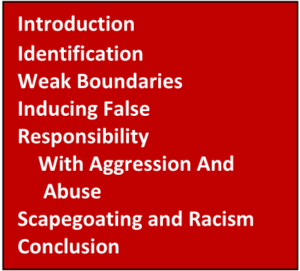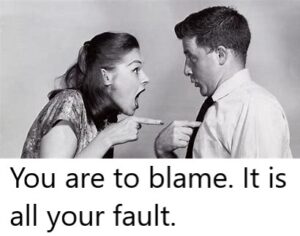Ending False Responsibility, Part (II)
INTRODUCTION
In the Letters on responsibility (beginning with the April Letter) we started with a definition of responsibility and pointed out the benefits of taking responsibility. In using the word responsibility we were referring to accountability. We moved onto exploring what false responsibility is and its destructive effects. In the October Letter we detailed some causes of false responsibility and many ways to free yourself from it.
In this Letter we continue to discuss some causes of false responsibility and ways to protect ourselves from accepting false responsibility. We explore identification, weak boundaries, and induced with aggression and abuse. We will briefly touch on the complicated topics of scapegoating and racism.
IDENTIFICATION
Identification is the process of developing the self by becoming like another person. This is a profound developmental process that occurs throughout the life cycle starting in early childhood where children identify with, become like, their parents. It extends into late adulthood where we identify with people we admire as part of our process of growth. When we identify with another person we open ourself up to them taking in parts of their personality, parts of who they are. In opening ourself up we become vulnerable. We usually do this automatically and unconsciously, without awareness. Children start life with openness and vulnerability. But they become closed and invulnerable if attacked and hurt.
The process of identification, of becoming like another person includes thinking the way (s)he thinks. Let’s say that a person you identify with makes a false statement of blame to shift responsibility. In thinking like him/her, in being willing to believe what he/she believes, you agree with the assignment of blame taking on the responsibility that does not belong to you. So when children who identify with their parents are blamed for things they are not responsible for they automatically accept the blame. Additionally, some children tend to take responsibility, to blame themselves, while other children tend to deny responsibility and blame others for their behavior.
Practice: Learn about the identification process which is a significant aspect of our life. Recognize the false responsibility that you accepted as a child due to identification with your parents and due to identification with other significant people in your life. Reject that false responsibility by saying no to it. Reject false responsibilities that you picked up as an adult from people you identify with, that you admire, and maybe love.
WEAK BOUNDARIES
As we examine this source of false responsibility it is useful to know something about our boundaries. A boundary is the imaginary line we draw between what is inside us and what is outside. Our skin is a physical example of a boundary. We also have mental (thought) and emotional (feeling) boundaries. Weak mental and emotional boundaries are characterized by self-doubt and by not knowing what we think and feel. We don’t have convictions about the validity of our beliefs or paradoxically we hold to our beliefs too rigidly. We doubt our right to think what we want and to feel whatever we feel.
draw between what is inside us and what is outside. Our skin is a physical example of a boundary. We also have mental (thought) and emotional (feeling) boundaries. Weak mental and emotional boundaries are characterized by self-doubt and by not knowing what we think and feel. We don’t have convictions about the validity of our beliefs or paradoxically we hold to our beliefs too rigidly. We doubt our right to think what we want and to feel whatever we feel.
Weak mental and emotional boundaries allow other people to “push” their ideas or feelings past our boundaries into us with their forcefulness, insistence, and intensity of feeling. We take their ideas and feelings in and make them our own. For example, with intense anger a person says, “You are to blame for my anger. You caused it.” The aggression of the intense anger that accompanies this statement actually pushes that statement past our boundary and into us, into our thoughts and feelings. We believe that we are to blame and feel guilty. Manipulations, statements of blame, accompanied by shame, guilt, anger, and fear push past our boundaries if our boundaries are weak. Children do not have fully developed boundaries and are therefore vulnerable to manipulation and aggression.
In ridding ourself of false responsibility we want to strengthen our boundaries. One thing that strengthens our boundaries is deciding what belongs to us and what does not. In examining this we are using our sense of our boundary, imagining the line that exists between internal and external, inside and outside of ourself. What is inside you is yours but may not belong to you. False responsibility has traveled past your boundary but does not belong inside you. Someone else or you put it there. Ending the false responsibility means eliminating its existence from within you, externalizing it by pushing it out past your boundary.
Point Of Empowerment: We defend our boundaries with No. “No, this responsibility does not belong to me and I refuse to let it cross my boundary. If it is already inside I reject it and rid myself of it.”
Here are examples of statements that help us protect and strengthen our boundaries with conviction.
- No, I don’t want that. I want this. This is my desire. For example, “No, I don’t want to visit my parents right now, I want to stay home.”
- No I don’t agree with that. I agree with (think) this. “I don’t agree that my voice is too loud. I think that I express myself intensely so that I am heard.”
- No I am not that. I am this. “No I am not prejudiced against you. I feel strongly about taking personal responsibility.”
- No I don’t feel that way. I feel this way. “No I am not depressed. I am sad that our relationship has so much conflict.”
- No I don’t believe that. I believe this. “No, I don’t think I was being argumentative when I disagreed with your idea. I believe that I was assertively stating my opinion.”
- I choose this and reject that. “I choose my diet and my health and reject your attempts to sabotage my diet. I have full control over what passes the boundary of my mouth.”
- I will allow this and not that. “I will allow you to make constructive criticisms of my behavior. I will not allow you to attack the person that I am.”
- Claiming rights strengthens boundaries. “I claim my right to be the person I am and to think and feel as I choose. I know that I am ok.”
Point Of Empowerment: To identify with is to take inside, to allow somethings to pass your boundary. Know your identifications and clarify you boundaries.
Practice: Projecting blame is a boundary violation. Strengthen your boundaries.
INDUCING FALSE RESPONSIBILITY WITH AGGRESSION AND ABUSE
There are two intensities of induced false responsibility with aggression, one more severe, one less severe. The more severe type involves abuse—physical, sexual, or emotional. The less severe type occurs in more ordinary, everyday life. In our Letters on false responsibility we have been discussing the less severe type. We now turn our attention to the more severe type of abuse.
Inducing false responsibility with aggression is behavior that violently pushes past a person’s boundaries. What gets induced with this violence is shame and rage, a shame and rage that does not belong to the person receiving the violence but belongs to the person perpetrating the violence. This occurs with physical, sexual, and/or emotional abuse. A person experiences the perpetrator’s shame and rage, assumes that it belongs to him/her, and that he/she owns and is responsible for it. Taking ownership is usually an unconscious, an out of awareness process. Additionally the statement that often accompanies abuse is, “You made me do this. It is your fault that I abused you.”
- “If you did not answer back I would not have hit you.”
- “If you were not such a cute child I would not have sexually abused you.”
- “You did not say anything so I thought you wanted sexual (abusive) activity.”
- “If you were not so temptingly vulnerable I would not degrade you or attack you verbally.”
There is a cycle of abuse where a person was abused and then abuses someone else. The abusive behavior actually transfers shame and rage to someone else so that the abuser momentarily feels less shame and rage and thus feels relieved. This relief is temporary so the abusive behavior is repeated. Recovering from abuse involves recognizing that the shame and rage that you feel does not belong to you and freeing yourself by expelling/rejecting it.
Point Of Empowerment: Inducing false responsibility with aggression is a violent act.
Point Of Empowerment: Freeing oneself of feelings that do not belong to you is similar to freeing oneself from false responsibility.
SCAPEGOATING AND RACISM
Scapegoating is the practice of assigning blame and responsibility for something in your life that you have responsibility for. You do not want to accept responsibility for the situation that you are in. Scapegoating is practiced by individuals, couples, families, groups, communities, and countries. It is a major cause of conflict because we want to punish those who we are scapegoating. Sometimes the people being scapegoated refuse to accept this false responsibility and sometimes they accept it. History is full of examples. The Spanish inquisition and Hitler’s Germany are two of history’s worse examples.
Racism has a number of different aspects. One aspect is scapegoating. “The reason our country has a bad economy is because of the ____, fill in the blank with Blacks, Jews, Catholics, Chinese, Hindus, Muslims, Russians, Africans, Mexicans . . . the list is long. “We are not responsible for the failure that we are experiencing. It is those____, they are responsible.” Racism may provide temporary relief from feelings of failure, inadequacy, anger, victimization or powerlessness. But the relief is never long lasting. Racism is self-perpetuating unless actively rejected by confront one’s personal beliefs.
Point of Empowerment: The antidote to scapegoating and racism is self-esteem and personal power. Taking responsibility is the key to both.
CONCLUSION
We have identified and discussed additional causes of false responsibility. We explained how refusal to take responsibility and blaming others, inducing false responsibility, leads to scapegoating and racism. Scapegoating and racism are rampant in our civilization today, but our awareness is growing about the destructiveness of these attitudes and behaviors. This is in contrast to the constructiveness of confronting our own beliefs about the people that we want to transfer our responsibility onto. In the January Letter we will expand our exploration of responsibility by discussing the relationship between responsibility and freedom.
